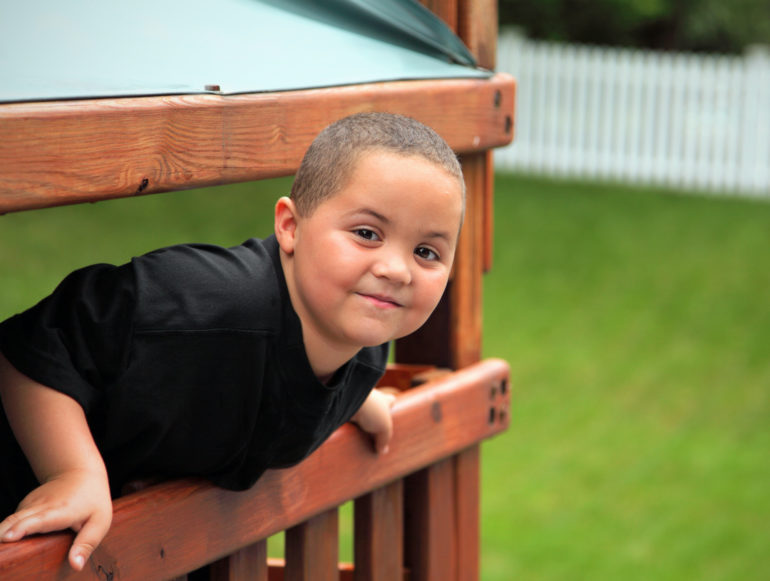A three-year intervention designed to reduce weight gain in overweight and obese Latino children generated improvements in body mass index and many other health measures during the trial’s initial two years, according to a study led by researchers at the Stanford University School of Medicine.
The finding could help clinicians, health educators and policymakers in their approach to reducing childhood obesity in populations at risk for the condition.
“We were able to change participants’ growth substantially over one to two years, which is a remarkable finding,” said Thomas Robinson, MD, professor of pediatrics and of medicine at Stanford, who led the study. Pediatric weight management focuses on moderating children’s weight gain as they continue gaining height, leading to a healthier BMI. Few studies have evaluated pediatric weight-control programs for longer than a year, and this is one of the first studies to show benefits to body weight and other health markers in a sample of low-income children from a racial or ethnic minority, said Robinson, who is also the Irving Schulman, M.D., Endowed Professor in Child Health.
However, the average body mass index between participants in the treatment group and those in the control group did not differ significantly by the end of the study.
A paper describing the research was published online in The Lancet Diabetes & Endocrinology.
In the United States, children from low-income, nonwhite populations are more likely to be obese and suffer from related health problems, such as Type 2 diabetes, than white children and children from higher socioeconomic tiers, prior research has shown. Yet children from low-income families often have less access to pediatric weight control programs and other components of healthy lifestyles—from nutritious food to walkable neighborhoods and after-school sports—than their higher-income peers.
Tailored intervention
The study enrolled 241 Latino children and their families living in low-income neighborhoods in the Bay Area. All children were 7-11 years old and overweight or obese when the research began. Participants underwent physical and laboratory tests at baseline and at one, two and three years.
The children were randomized to two groups. The treatment group participated in a multifaceted program that involved the children’s families, communities and primary health care professionals. The program incorporated cultural values shared broadly among members of the Latino community. Families received home visits and phone calls from a health educator, and they had the opportunity to complete behavior-change modules on reducing food portions, making healthier food choices, increasing physical activity, reducing screen time, and parenting and problem solving around food and lifestyle choices. Participants chose which modules to complete and when.
Children in the treatment group were also encouraged to participate in an after-school sports program, which they could attend up to five days per week. Delivered at local community centers, this program included about 40 minutes per day of physical activity and provided a venue for playing team sports for fun.
Members of the control group were provided with a state-of-the-art health education program consisting of two home visits with a health educator per year, monthly health education newsletters, quarterly educational presentations and a few social events per year. The control was designed to provide families with a beneficial treatment of their own through the entire study.
Changes in body composition, eating and activity
When the study began, about three-quarters of participants were classified as obese, with a BMI above the 95th percentile for their age and sex. Nearly three-quarters had abnormal blood lipid levels or pre-diabetes, or both.
The children in the treatment group maintained significantly healthier BMIs than those in the control group in the first two years of the study. The difference between groups was not statistically significant by three years.
“With our multi-level intervention, kids and families were able to control weight over one and two years even compared to state-of-the-art health education,” Robinson said.
The children in the treatment group also had significantly better results on multiple health measures at one or two years, or both, including diastolic blood pressure, total cholesterol and LDL cholesterol. They were more physically active after school and spent less time being sedentary. They had healthier diets and eating behaviors by several measures, including total daily energy intake, percentage of dietary energy from fat and daily energy consumed while watching screens. Some improvements in eating and diet persisted throughout the three-year study period.
More than 94% of participants completed annual health evaluations throughout all three years of the study. However, participants in the treatment group spent less time working on the education modules and participating in the sports program as the study progressed, which the researchers think may explain why the effects became weaker after three years.
“A lot happens in three years,” Robinson said. Some life changes, such as moves, job losses and parental separations, made it harder for families to continue to participate in the study.
In contrast, other events could increase a family’s motivation to participate, such as when the family wanted to change what they ate because an adult member was diagnosed with diabetes. “We purposely designed the intervention to take advantage of those critical moments, so that when you needed the intervention, it was there for you,” Robinson said.
The findings will inform future efforts to help the highest-risk kids and families receive weight-management resources that work for them, Robinson said.
“The changes we saw are very positive, and good evidence that there’s a lot of promise for this community-based, multi-level model of intervention,” he said. “It motivates us: There’s more to learn, and more we can improve on.”
A home-based weight management program benefits both children and parents
More information:
Thomas N Robinson et al. A community-based, multi-level, multi-setting, multi-component intervention to reduce weight gain among low socioeconomic status Latinx children with overweight or obesity: The Stanford GOALS randomised controlled trial, The Lancet Diabetes & Endocrinology (2021). DOI: 10.1016/S2213-8587(21)00084-X
Provided by
Stanford University Medical Center
Citation:
Study helps Latino children manage obesity over two years (2021, April 30)
retrieved 2 May 2021
from https://medicalxpress.com/news/2021-04-latino-children-obesity-years.html
This document is subject to copyright. Apart from any fair dealing for the purpose of private study or research, no
part may be reproduced without the written permission. The content is provided for information purposes only.

